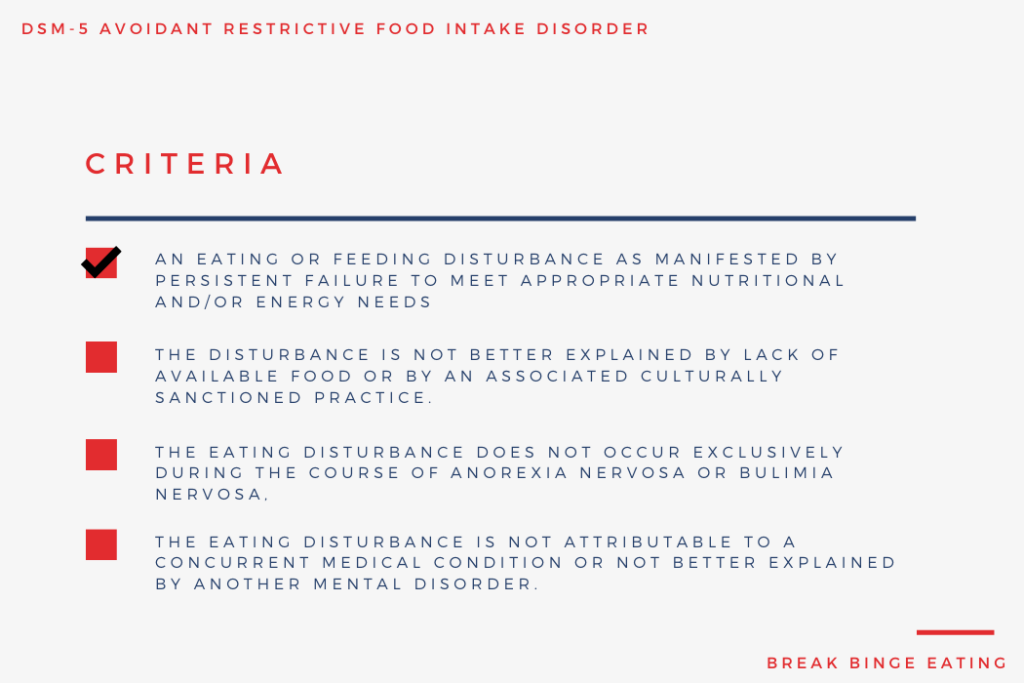Avoidance Restrictive Food Intake Disorder (ARFID) was first introduced in the DSM-5 as a specific type of feeding and eating disorder.
Although ARFID was traditionally viewed as a feeding disorder that occurred during infancy and childhood, there is more and more evidence showing that ARFID symptoms can occur across all stages of life.
Table of Contents
What is Avoidant Restrictive Food Intake Disorder (ARFID)
Avoidant Restrictive Food Intake Disorder (ARFID) is a food aversion disorder that is characterized by restrictive eating leading to poor growth and development due to the resulting vitamin and mineral deficiencies 1Fisher, M. M., Rosen, D. S., Ornstein, R. M., Mammel, K. A., Katzman, D. K., Rome, E. S., … & Walsh, B. T. (2014). Characteristics of avoidant/restrictive food intake disorder in children and adolescents: a “new disorder” in DSM-5. Journal of Adolescent Health, 55(1), 49-52.
The DSM-5 provides three presentations of ARFID, which can occur independently or in combination.
- Where individuals with sensory sensitivity may avoid eating specific foods—often meats, vegetables, and/or fruits—due to aversions to specific tastes, textures, or smells.
- Where individuals may restrict the amount they eat due to lack of interest in eating or low appetite.
- Where others may avoid specific foods or stop eating entirely following a traumatic experience with eating, such as choking, vomiting, or other forms of gastroenterological distress.
In all cases, ARFID is a type of that is associated with significant psychological distress and usually
Importantly, ARFID is not associated with body image disturbances like the other eating disorders, such as anorexia nervosa and bulimia nervosa.
Diagnostic Criteria for ARFID

According to the DSM-5, ARFID is diagnosed when:
- An eating or feeding disturbance (e.g., apparent lack of interest in eating or food; avoidance based on the sensory characteristics of food; concern about aversive consequences of eating) as manifested by persistent failure to meet appropriate nutritional and/or energy needs associated with one (or more) of the following:
- Significant weight loss (or failure to achieve expected weight gain or faltering growth in children).
- Significant nutritional deficiency.
- Dependence on enteral feeding or oral nutritional supplements.
- Marked interference with psychosocial functioning.
- The disturbance is not better explained by lack of available food or by an associated culturally sanctioned practice.
- The eating disturbance does not occur exclusively during the course of anorexia nervosa or bulimia nervosa, and there is no evidence of a disturbance in the way in which one’s body weight or shape is experienced.
- The eating disturbance is not attributable to a concurrent medical condition or not better explained by another mental disorder. When the eating disturbance occurs in the context of another condition or disorder, the severity of the eating disturbance exceeds that routinely associated with the condition or disorder and warrants additional clinical attention.
Subtle ARFID Signs and Symptoms
You can usually spot an ARFID case because the psychological and behavioural profile of these individuals is quite outstanding.
Here are some key behavioural and psychological signs of ARFID:
- Rapid weight loss
- Severely restricting the types or amount of food eaten
- Recurring constipation, lethargy, and stomach pains
- Loss of interest in food or lack of appetite
- Extremely fussy with eating
- Picky eating occurs in the absence of body image concerns
- Anxiety around choking or vomiting
- Limiting food types based on their texture
- Goes to great lengths to hide weight loss.
There are also many different physical signs of ARFID:
- Menstrual irregularities
- Impaired concentration
- Dizziness
- Insomnia
- Dry skin
- Brittle nails
- Muscle weakness
- Impaired immune functioning
- Low potassium
- Shivers
- Feet swelling
ARFID Statistics
Given that ARFID is a relatively no new eating disorder, large-scale research on the prevalence, incidence and course of ARFID is lacking.
Below are some key statistics on ARFID based on existing research.
- Among 1,444 primary school children in Switzerland, around 3.2% met criteria for ARFID2Kurz S, van Dyck Z, Dremmel D, Munsch S, Hilbert A. Early-onset restrictive eating disturbances in primary school boys and girls. Eur Child Adolesc Psychiatry. 2015;24(7):779–85.
- Between 6.2 to 17.4% of individuals in eating disorder treatment programs exhibit ARFID-like symptoms3Ornstein RM, Rosen DS, Mammel KA, Callahan ST, Forman S, Jay MS, et al. Distribution of eating disorders in children and adolescents using the proposed DSM-5 criteria for feeding and eating disorders. J Adolesc Health. 2013;53(2):303–5.
- Around 14% of adolescents seeking treatment for an eating disorder met criteria for ARFID.
- Compared to anorexia nervosa and bulimia nervosa, those with AFRID are more likely to be men, younger, and have a longer duration of illness 4Fisher, M. M., Rosen, D. S., Ornstein, R. M., Mammel, K. A., Katzman, D. K., Rome, E. S., … & Walsh, B. T. (2014). Characteristics of avoidant/restrictive food intake disorder in children and adolescents: a “new disorder” in DSM-5. Journal of Adolescent Health, 55(1), 49-52.
- Around 30% of ARFID cases are men5Fisher, M. M., Rosen, D. S., Ornstein, R. M., Mammel, K. A., Katzman, D. K., Rome, E. S., … & Walsh, B. T. (2014). Characteristics of avoidant/restrictive food intake disorder in children and adolescents: a “new disorder” in DSM-5. Journal of Adolescent Health, 55(1), 49-52.
- The 3-month prevalence of ARFID in Australian adults is 0.3%6Hay, P., Mitchison, D., Collado, A. E. L., González-Chica, D. A., Stocks, N., & Touyz, S. (2017). Burden and health-related quality of life of eating disorders, including Avoidant/Restrictive Food Intake Disorder (ARFID), in the Australian population. Journal of eating disorders, 5(1), 21.
ARFID is not just picky eating
A common misconception is that ARFID merely represents picky eating and it is just part of normal development.
Yes it’s true that picky eating and ARFID share some similarities, but there are also important differences.
ARFID is differentiated by the level of distress and impairment that eating causes. For example, someone with ARFID may have difficulty chewing or swallowing, and can even gag in response to eating something that gives causes anxiety. The anxiety can also cause them to avoid any social eating situation, such as a birthday party.
Further to this, ARFID, unlike picky eating can cause some serious health issues, including significant weight loss, stunted growth, and nutritional deficiency.
ARFID in Adults
It’s well-known that ARFID is concentrated in children or younger populations.
However, ARFID is becoming increasingly more common in adults, particularly in men, with the increase in certain diet trends such as vegan diets, gluten-free diets, alternative fasting and other popular diets that eliminate one or more food groups7Zickgraf, H. F., Franklin, M. E., & Rozin, P. (2016). Adult picky eaters with symptoms of avoidant/restrictive food intake disorder: comparable distress and comorbidity but different eating behaviors compared to those with disordered eating symptoms. Journal of eating disorders, 4(1), 1-11.
Adults with ARFID will have a small range of foods that they will eat. Case reports suggest that adults with ARFID may eat less than 20 food types.
These individuals may refuse to try new foods, or report higher rates of texture or sensory issues to food.
There is some evidence suggesting that picky eating and elevated levels of dietary restraint are associated with ARFID onset in adults, while other research suggests that ARFID and anorexia nervosa symptoms can occur to a high extent8Lieberman, M., Houser, M. E., Voyer, A. P., Grady, S., & Katzman, D. K. (2019). Children with avoidant/restrictive food intake disorder and anorexia nervosa in a tertiary care pediatric eating disorder program: A comparative study. International Journal of Eating Disorders, 52(3), 239-245.
ARFID in adults is just as serious as other adult eating disorders.
For example, research shows that adults with ARFID show comparable levels of functional impairment, internalising distress, and obsessive-compulsive symptoms to people with other types of eating disorders 9Zickgraf, H. F., Franklin, M. E., & Rozin, P. (2016). Adult picky eaters with symptoms of avoidant/restrictive food intake disorder: comparable distress and comorbidity but different eating behaviors compared to those with disordered eating symptoms. Journal of eating disorders, 4(1), 1-11..
References

Leave a Reply